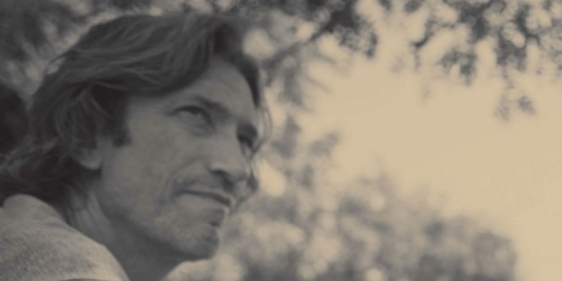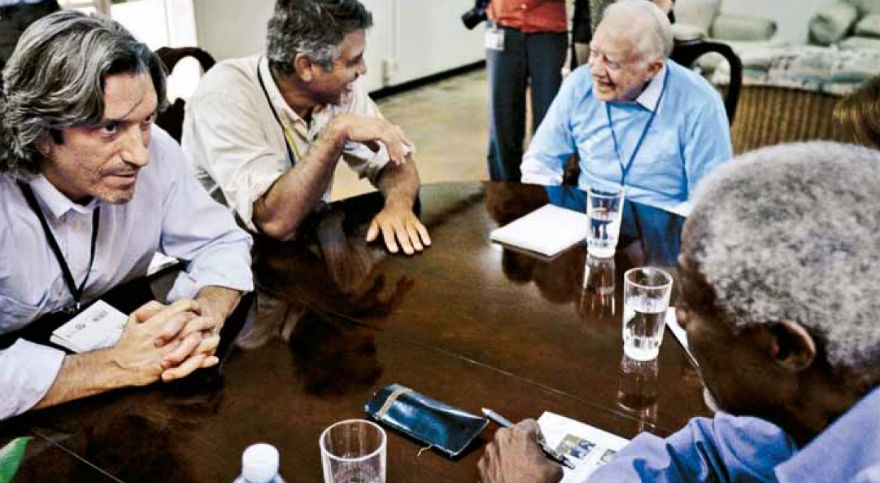Heart of Africa

Story by Renee Cree, SMC ’12
Shortly before midnight on July 9, 2011, the people of Juba, a small outpost in southern Sudan, gathered around a large digital clock in the square, counting down the seconds until the region became South Sudan, the world’s first new nation since 1993. Juba would be its capital.
The clock struck, and an explosion of joy and celebration erupted. People danced in the square, drove though the city honking their horns and waved their country’s new flag. The next morning was bright and sunny in the middle of the rainy season, as if to reflect the exuberance that filled the streets. A marching band performed “South Sudan, Oyee,” the new country’s national anthem. President Salva Kiir read from its new constitution.
John Prendergast, CLA ’86, says the joy in South Sudan was palpable. “It was euphoric,” he says now, on the eve of the country’s first birthday. “For many people, it was the culmination of a lifelong dream.”
Prendergast has been dreaming of peace in Africa since he majored in geography and urban studies at Temple. That was when he first saw images of the famine in Ethiopia in 1983. “I couldn’t believe human suffering could still exist on such an operatic scale,” he says. “I felt it necessary to respond directly, personally.”
And respond he did. While still enrolled at Temple, Prendergast made his first trip to Africa, despite knowing little about the political situation there. He says that first trip irrevocably changed his career aspirations and life path. For nearly 30 years, he has dedicated himself to social justice in some of Africa’s most volatile areas, including Rwanda, the Democratic Republic of the Congo, Sudan and now, South Sudan.
ROAD TO FREEDOM
Sudan was two different countries long before South Sudan officially seceded.
“There was a very strong North African, Arab and Turkish influence in the north,” says Benjamin Talton, associate professor of history in the College of Liberal Arts. “And in the south, Britain imposed a structure that was more in line with its colonial practices in the rest of sub–Saharan Africa, including the presence of Christian missions from Europe, which Britain did not allow in the north.”
Even when the country broke away from British and Egyptian rule in 1956, two civil wars raged almost back–to–back for the next 50 years, costing 2.5 million Sudanese their lives and leading to widespread displacement. In large part, the conflicts stemmed from a broken agreement by the government in Khartoum to allow the south to operate in a semi–autonomous state.
“The government declared its intention to impose Islamic law throughout the country, even in the south, where Islam is not the predominant faith,” Talton says. “This was in patent violation of the south’s semi–autonomous status.”
Further, Prendergast notes that the north never fully invested in the south with proper resources or infrastructure, leading to southerners’ harboring “tremendous grievances” against the north. These grievances led to the formation of the Sudan People’s Liberation Army (SPLA), a rebel group based in the south that would fight the government for nearly 20 years during the Second Sudanese Civil War.
WAR AND PEACE
But it was not a war that led to the eventual secession of South Sudan—it was peace. In 2002, a ceasefire was established with the support of the Intergovernmental Authority on Development, a confederation of the governments of Eritrea, Ethiopia, Kenya and Uganda. Peace talks began in earnest and culminated in 2005, when SPLA and the Sudanese government signed the Nairobi Comprehensive Peace Agreement. The signing marked the end of the last civil war, and ensured that the south would finally be granted its autonomy for six years, followed by a referendum to vote on its independence.
When the time came to hold the referendum, the threat of another war loomed. If South Sudan did leave, it would take with it a third of the country’s land and almost 80 percent of its oil resources—a possibility that did not sit well with the administration of Sudanese president Omar al–Bashir. Military intelligence from around the world began to speculate on what Bashir might do to prevent the country from splitting.
Prendergast wanted to help minimize the possibility of war. Through the Enough Project, the human–rights organization he co–founded in 2006, he launched a full–scale campaign to raise awareness about the situation in Sudan, and the need for the referendum on South Sudan’s independence to move forward. As he campaigned, the atrocities that had swept through Darfur since 2003—famine, rape and murder—haunted him. He aimed to keep them from spreading through South Sudan.
To do so, he enlisted the help of actor and director George Clooney and gave dozens of interviews, raising awareness in the media to stop what he calls a self–fulfilling prophecy: “The less media outlets cover Africa, the less people know, so the less they demand news agencies increase their coverage.” He also met with U.S. President Barack Obama and other diplomats to urge them to monitor events in Sudan.
The momentum he helped create in support of South Sudan’s independence ensured that the referendum moved forward as scheduled in January 2011. He arrived in the volatile Abyei region of Sudan just before the referendum took place. Only a few miles away, a skirmish between two neighboring tribes resulted in more than 100 deaths while Prendergast visited refugee camps and spoke with inhabitants about their opportunity to liberate southern Sudan.
He then traveled to Juba and visited several polling stations. There, he met with former U.S. President Jimmy Carter, another staunch supporter of South Sudan’s independence, and Kofi Annan, former secretary–general of the United Nations. The four men have met for years to discuss strategies to support peace and justice in Sudan. At this latest meeting, they deliberated how the momentum of the referendum could help alleviate the conflicts in Darfur and Abyei.
Despite the harrowing threat of violence, nearly 99 percent of Southern Sudanese people voted for their independence. South Sudan was born seven months later, without the two countries going to war once again.
HURDLES AHEAD
South Sudan has struggled during its first year. In the months since the country declared its independence, violent skirmishes have erupted along the Sudan–South Sudan border, particularly in the volatile, oil–rich area of Abyei. Both countries are attempting to claim it as their own. In addition, each contends that the other’s military forces continue to wreak havoc. Sudan has been accused of attacking South Sudan with aerial bomb raids and ground assaults, while SPLA has been accused of raping and torturing members of the Murle tribe, which received military aid from Khartoum during the most recent civil war. The fighting has pushed the two countries dangerously close to another all–out war.
“It has been a very difficult first year,” Prendergast says. “There have been internal conflicts in the south, and a brewing showdown with the Sudan the south left behind. Corruption issues also have undermined rapid progress. And the south turned off the oil pipeline that runs through the north to Port Sudan, which has created conditions for a real economic recession.”
Earlier this year, the African Union sponsored talks between the two countries to discuss disputed issues including oil revenue payments, citizenship status and the delineation of the border between the two countries. Though conflicts stalled the initial round of talks, both presidents had agreed to meet and resume negotiations at the time this article was written.
Prendergast says that a stronger international diplomatic effort is needed to ensure lasting peace between Sudan and South Sudan, and is embarking on another media campaign to highlight those needs. “We need to improve our game in support of the African–led peace process, and we need to do much more to promote a political transition in Khartoum,” he says.
Prendergast’s nonprofit also is monitoring activities along the border with the Satellite Sentinel Project. It is an effort to monitor both nations via satellite for possible indications of war, such as mobilized troops or bombed villages. The Enough Project works with the Harvard Humanitarian Initiative, Google and satellite provider DigitalGlobe to analyze information and release reports to the media and legislators, keeping the world’s attention focused on the fragile region.
“After the independence of South Sudan, I think the world breathed a collective sigh of relief, as if the troubles in this area would just melt away,” says Carolyn Adams, professor of geography and urban studies, who taught Prendergast as a student. “But we can’t assume that there will always be peace and prosperity. That’s what John is working on now—letting the world know that the separation isn´t the end of the problems.”
A tireless activist, Prendergast still travels back and forth between the U.S. and Africa, making three to four trips per year. He visits war zones and stays in refugee camps and villages to get a real sense of what people need. Recently, he headed back to Sudan and South Sudan “to assess the human–rights situation and see what we can do to help.”
Despite a rough beginning, Prendergast is optimistic about South Sudan’s future, and for peace across Africa. “Much of Africa is a success story, in which elections are being held to determine leaders, governments are investing in good economic policies and democratic institutions are being built,” he says. “We have a long way to go, but Africans themselves are leading the effort to change the damaging status quo.”
DEEP IMPRESSION
Since first arriving in Africa nearly 30 years ago, Prendergast has become a renowned activist for peace there. He has served as director of African Affairs at the National Security Council under former U.S. President Bill Clinton and as special advisor to Susan Rice, U.S. ambassador to the United Nations. He also has worked for several human–rights organizations, including Human Rights Watch, the United States Institute of Peace and Not On Our Watch.
Prendergast returned to Main Campus in fall 2011 as the Leonard Mellman Visiting Scholar in the College of Liberal Arts. He shared his vision of the past and future of Africa, and empowered students by sharing with them strategies for effecting social change. Also during his visit, Prendergast was named a Temple University Alumni Association Alumni Fellow.
“John is generally an optimist, and he knows the people of Africa can continue to make headway,” Adams says. “For the rest of the semester, when discussing social justice issues, the students would say, ‘How would John handle this problem?’”
